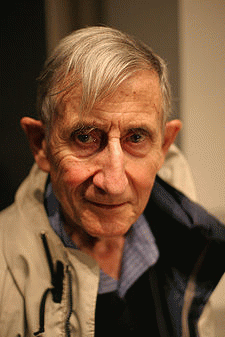"In January 1939 a meeting of physicists was held at George Washington University in Washington, D.C. The meeting had been planned by George Gamow long before fission was discovered. It was one of a regular series of annual meetings. It happened by chance that Neils Bohr arrived in America two weeks before the meeting, bringing from Europe the news of the discovery of fission. Gamow quickly reorganized the meeting so that fission became the main subject. Bohr and Enrico Fermi were the main speakers. For the first time, the splitting of the atom was publicly described, and the consequent possibility of atomic bombs was widely reported in the newspapers. Not much was said at the meeting about atomic bombs. Everyone at the meeting was aware of the possibilities, but nobody spoke up boldly to suggest that questions of ethical responsibility be put on the agenda. The meeting came too soon for any consensus concerning ethical responsibilities to be reached. Most of the people at the meeting were hearing about fission for the first time. But it would have been possible to start a preliminary discussion, to make plans for an informal organization of physicists, and to prepare for further meetings. After several weeks of preparations, a second meeting might have been arranged with the explicit purpose of reaching an ethical consensus.
...(By 1941, the) fear of Hitler was so pervasive that hardly a single physicist who was aware of the possibilities of nuclear weapons could resist it. The fear allowed scientists to design bombs with a clear conscience. In 1941 they persuaded the British and American governments to build the factories and laboratories where bombs could be manufactured. It would have been impossible for the community of British and American physicists to say to the world in 1941, "Let Hitler have his nuclear bombs and do his worst with them. We refuse on ethical grounds to have anything to do with such weapons. It will be better for us in the long run to defeat him without using such weapons, even if it takes a little longer and costs us more lives." Hardly anybody in 1941 would have wished to make such a statement. And if some of the scientists had wished to make it, the statement could not have been made publicly, because all discussion of nuclear matters was hidden behind walls of secrecy. The world in 1941 was divided into armed camps with no possibility of communications between them. Scientists in the Soviet Union were living in separate black boxes. It was too late in 1941 for the scientists of the world to take a united ethical stand against nuclear weapons. The latest time that such a stand could have been taken was in 1939, when the world was still at peace and secrecy not yet been imposed.
...In October of 1995, I was giving a lunchtime lecture to a crowd of students at George Washington University about the history of nuclear weapons. I told them about the meeting that had been held in a nearby building on their campus in January 1939. I told them how the scientists at the meeting missed the opportunity that was fleetingly placed in their hands, to forestall the development of nuclear weapons and to change the course of history. I talked about the nuclear projects that grew during World War II, massive and in deadly earnest in America, small and halfhearted in Germany, serious but late-starting in Russia. I described the atmosphere of furious effort and intense camaraderie that existed in wartime Los Alamos, with the British and American scientists so deeply engaged in the race to produce a bomb that they did not think of stopping when the opposing German team dropped out of the race. I told them how, when it became clear in 1944 that there would be no German bomb, only one man, of all the scientists in Los Alamos, stopped. That man was Joseph Rotblat. I told how Rotblat left Los Alamos and became the leader of the Pugwash movement, working indefatigably to unite scientists of all countries in efforts to undo the evils to which Los Alamos gave rise. I remarked how shameful it was that the Nobel Peace Prize, which had been awarded to so many less deserving people, had never been awarded to Rotblat. At that moment one of the students in the audience shouted, "Didn't you hear? He won this morning." I shouted, "Hooray," and the whole auditorium erupted in wild cheering. In my head the cheers of the students are still resounding."
(Excerpted from The Force of Reason, Chapter 12, pages 133-38, of The Scientist As Rebel by Freeman Dyson, New York Review hardback edition.)





